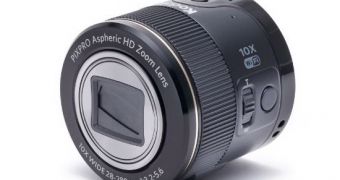One more day until this year's CES show ends, and we've seen quite a few interesting announcements coming from all major digital camera and optics manufacturers on the market.
Among others, at CES 2014 Kodak has announced the company's first MFT (Micro Four Thirds) interchangeable-lens digital camera as well as three new superzoom bridge cameras as part of its Astro Zoom series.
Besides that, the company also introduced two new lens-style camera models as part of the Pixpro Smart Lens series, which aims to compete with Sony's QX100, QX10 SMART lenses. That being said, let's see if these lenses are worth their money, at least on paper.
As Sony's models, both lenses can be used as a superzoom optic for smartphones and tablets, but can also use these gadgets as a remote viewfinder via Wi-Fi.
The two models introduced by Kodak are SL10 and SL25. The Kodak SL10 Smart Lens is the cheapest of the two and comes with a 10x optical zoom lens that provides a focal length of 28-280mm (35mm equivalent). Since it can also be held in your hand to take pictures, the lens comes with integrated optical image stabilization that compensates movement to deliver sharp, clear images.
In addition to that, SL10 is capable of capturing 1080p Full HD video footage and comes with micro SD card support for enhanced storage space. The company will also release Android and iOS compatible applications to control the lens and also mentions that the SL10 will be available starting this spring at a price of $199 / €146.
The Kodak SL25 comes with a 25x optical zoom lens which covers focal length of 24-600mm (35mm equivalent), is capable of capturing 1080p video footage, supports micro SD cards and, like its cheaper sibling, comes with a sleep function that allows it to preserve battery when not used.
The SL25 will also hit market shelves in spring with a $299 / €220 price tag. Until now, the company hasn't mentioned anything about NFC support or the types of sensors integrated in these lenses.

 14 DAY TRIAL //
14 DAY TRIAL //